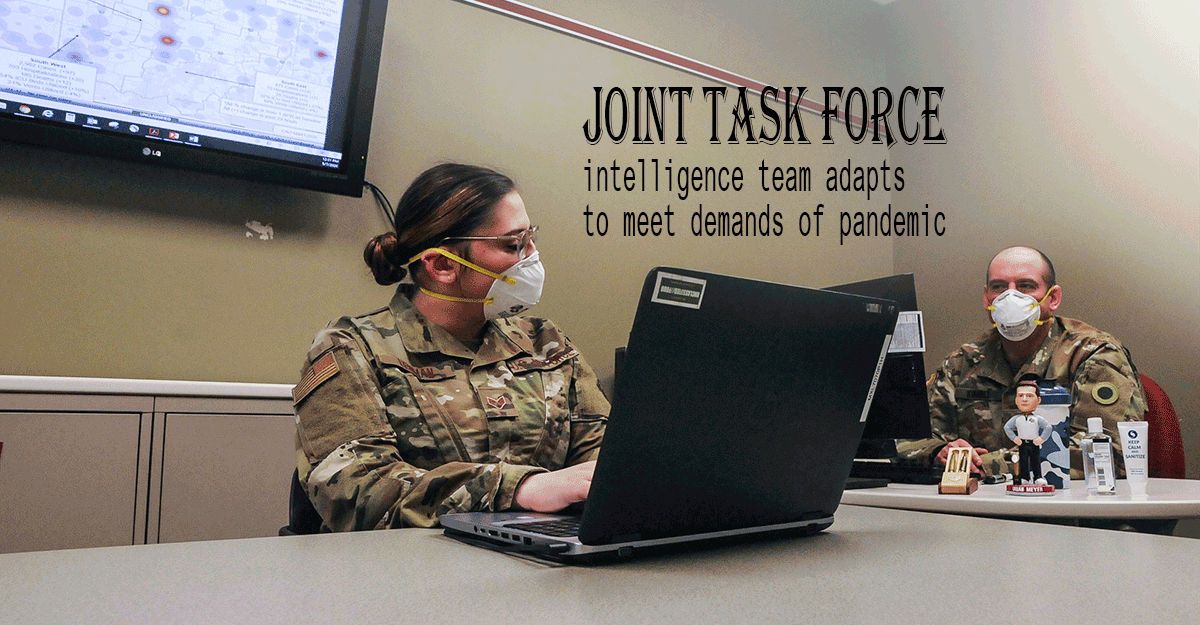Joint task force intelligence team adapts to meet demands of COVID-19 pandemic
Story by 1st Lt. Kevin Livingston, Ohio National Guard Public Affairs
COLUMBUS, Ohio (07/13/20)
The joint task force created in March to oversee Ohio National Guard support during the state’s COVID-19 pandemic response has been able to use its dynamic capabilities to serve Ohioans in many ways.
One prime example is the joint task force’s military intelligence section, comprising both Army and Air National Guard members. The varied experiences of the team members enable the section to stay one step ahead in the fight against the novel coronavirus. While traditional military intelligence teams look at opposing forces in operational landscapes overseas, the JTF team has switched gears to a medical focus for Ohio and surrounding states. Its primary mission is to collect and analyze data for operational planning.
According to Chief Warrant Officer 2 Jeremy Kimble, the JTF’s all-source intelligence technician, the team tracks the virus’ impact, including hospitalizations and ICU admissions.
“We are providing the best data to make the (JTF) commander aware of the totality of the situation in the state,” Kimble said. “That allows him to make any decision necessary for the Soldiers and Airmen to go on mission and remain safe.”
Between staggered teleworking and in-office shifts, the team continually works to review state and national COVID-19 data to deliver to the JTF commander. This helps shape and proactively influence developing operations throughout Ohio.
Partnering with state agencies, including the departments of Health; Job and Family Services; Rehabilitation and Correction; and the state Emergency Management Agency, has allowed the team to combine military practices with external strategies to capitalize even further on information gathering and reporting.
According to Senior Airman Elise Lehman, an all-source intelligence analyst on the team, and Kimble, the collaboration has also been instrumental in their success.
“We have built a better sharing network with our state and federal partners,” Kimble said. “We now have names and faces to go to when gathering data and reports to better inform the commander, as well as share with state departments tracking the virus.”
Added Lehman: “Every one of us is working our hardest to make sure we come out of this stronger,” she said. “I can see the impact this has had on the community as a whole, and we will keep working to support our troops and our community.”
Using their combined resources and partnerships, the team identified a critical shortfall in the state’s COVID-19 response as it related to nursing homes and long-term care facilities. As a result of the team’s data collection and research, the Ohio National Guard assembled about a dozen teams, at the direction of Gov. Mike DeWine, to assist with COVID-19 test collection and temporary staffing at Ohio’s 960 long-term care facilities across the state. Teams of medically qualified personnel are currently supporting the Ohio Department of Health with the COVID-19 testing collection mission.
Kimble and Lehman, along with their fellow team members, will continue to track potential mission opportunities and COVID-19 hot spots for as long as the need exists. The team, along with the Ohio National Guard as a whole, remains dedicated to serving all Ohioans.
“We have looked at every different social and economic status in Ohio to make sure no one is left behind,” Lehman said. “We really are all in this together.”
